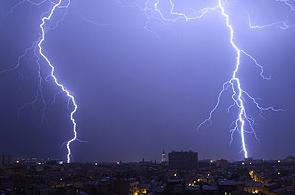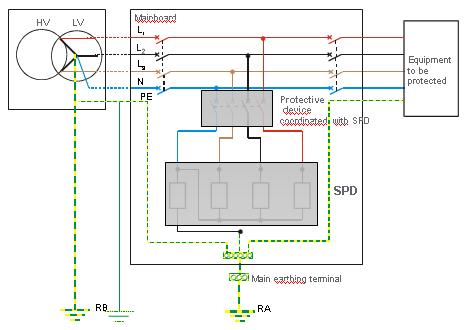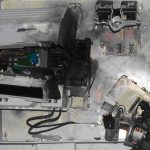after 15 years of experience I feel important to come back to some basics
Protection against the destructive lightning effects should be considered globally.
To avoid the fire of a building we will use the “external” lightning protection system such as lightning conductor or meshed cage.
In the same way, we will install Surge Arrester or surge protector (also called SPD, Surge Protective Device) in the Electrical main board to protect sensitive electrical equipment against surges generated by lightning strokes fell close or directly on the building.
15 years of experience in the field of surge protection lead me to write that the technology and understanding of phenomena has evolved. However, further issues have to be clarified …
One of the main issues to clarify in my opinion is the behaviour of the surge arrester, “surge protector“ (SPD) implemented in an electrical panel. Today many designers think it is enough to connect a surge protector (SPD) on the grid so that it provides protection against surges caused by lightning effects. Of course, this role is the main function of the surge protector (SPD). Nevertheless we have to consider its integrity in operation, outside a period of storm, mainly during the permanent fault on the electrical power network.
In other words, a surge protector (SPD) must be coordinated with a safety protective device that disconnects from the network when the SPD is in short circuit. The cause of this development are mainly short-circuit failure of the neutral or permanent overvoltage which unfortunately appear on the electrical networks (from current or renewable energy)
Surge protection can be effective and safe if this association is coordinated with its protective device (Circuit breaker or fuse). For example, surge protector (SPD) with nominal current discharge In=5kA should be associated with a circuit breaker C curve – 20A, breaking capacity consistent with Isc of the electrical installation from (6KA to 25kA)
by the way, you can visit this lafoudre.com : Interesting web site dealing with the lightning phenomena in the several fields as meteorology, medical, scientific and technical – in French and English languages
Didier Mignardot



I’m from Mongolia. I’m not good at English. Now I am working and studying power engineering (high voltage earthing research) is there any one who share with your skills. if so thank you very much.
Hello,
Could you be little more specific because Lightning protection is a large field .
Hello,
I am cambodia.I am not well in writing English,working at Siem Reap diesel power plant(10MW).Now my country has many lightnings during raining that kills people, damages eletrical overhead transmission line(22kv) and low voltage electric devices.
could you help me, how protection,how to get a good skill in surge protection ! ! !
Hello,
I suggest to have a look on standardization guide . This is the IEC 61643-21 or the Electrical Installation Guide chapter J dedicated to Surge arrester:
http://www.electrical-installation.schneider-electric.com/ei-guide/j-protection-voltage-surges.htm
Hello,
I just read the Electrical Installation Guide ,chapter J :Protection against voltage surges in LV , so i can uderstand about lightning & surge protection better than before.
thanks Mr Mignardot that provided me a home page.
best regard
BOTH;cambodia
sereybothmay@yahoo.com
I suggest you could also download the document “Cahier Technique n°151”, which deals with overvoltages and insulation coordination for MV and could complement what you found in the LV guide, from the Schneider-Electric web site at the following address:
http://www.schneider-electric.com/documents/technical-publications/en/shared/electrical-engineering/electrical-know-how/high-voltage-plus-1kv/ect151.pdf
Have a good reading,
Our company manufactured surge protector. any question you can direct to my email itachidungga@yahoo.com.my
i want to know the Contruction and Functioning principle of MOV,GDT.
Let me know about your works to enable us to proposed our products
Lighting arrester is a infinite source of electrone and proton so It is the better path of protecting of electrical and electronic equipment.
The information you include about SPD´s iwill mislead the opinion of
engineers
because there´re manufacturers that had consider the problem and
include a fuse in front
of each MOV, designed to open the circuit in case of a failure or end of life of the varistor.
but it´s not any fuse, because it goes in the protection module in front of each MOV. On the other hand a limiting fuse for protection will jeopardize the function of the SPD
This is a very interesting comment because you give me the opportunity to clarify the end of life mode of SPD (including MOVs and gas tube):
Let me explain two cases.
A surge arrester can happen at the end of life in the following cases:
a) by thermal runaway due to an accumulation of excessive constraints of not exceeding its lightning
attributes, leading to a slow destruction of its internal components.
The disconnection of the SPD is provided by a thermal fuse associated with the electronic components (MOVs) inside the SPD
b) by short-circuit due to exceeding the maximum flow capacity or due to a fault under 50hz from the electrical distribution network (neutral rupture ,…). The disconnection of the SPD is provided by an external or integrated short circuit protection device like fuse or circuit breaker.
Considering the short circuit protection device(b), why choose circuit breaker instead of fuse?
● Choose the rating must consider both surge withstand and low short circuit breaking capability
● Compare to fuses, CBs have good compromise between surge withstand and low short circuit breaking capability
*The same rating CB has better surge withstand capability than fuse
*The lower rating CB has better short circuit breaking capability
For instance, SPD with following characteristics : In=5kA, Up=1,3kV is coordinated with its short circuit protection device:
* circuit breaker C curve 20A
* or fuse 22×58 63A
Fuse only functioned in steady state condition.But lightning & surge happened in transient condition.The different is times d/dt .
Some other manufacture use the fuse is to protect the current and temperature.for normal supply current is below than 2-3A.That why manufacturer will used fuse rating 10-15A.Depend on rating MOV’s.
Thanks for this post
i am studying short circuit calculation for power systems.pls send me the data for designing and selection of protective devices for sc
As you can see below, coordination between SPD and MCB(F2 in the text) is given by the manufacturer’SPD instructions
extract from IEC 60364-5-534:
“534.2.4 Protection against overcurrent and consequences of an SPD failure
Protection against SPD’s short-circuits is provided by the overcurrent protective devices F2
(see figures in the annexes A to D) which are to be selected according to the maximum
recommended rating for the overcurrent protective device given in the manufacturer’s SPD
instructions.”
moreover the product standard IEC 61643-11 refers to disconnector (overcurrent protective devices) as you can show below:
extract from IEC 61643-11/2005:
” 6.2.7 SPD disconnector
The SPD may have SPD disconnectors (which can be either internal, external or both). Their
operation shall be indicated.
NOTE Installation requirements not related to the SPDs may require additional and/or lower rated overcurrent protective devices.
SPD disconnectors shall be tested with the SPD during the sequence of type tests of 7.7 and
7.8.3, except for RCDs, which are not tested during the operating duty test according to
7.7.1.”
My advice is to contact manuifacturer’s SPDs and ask to them this coordination table
Please refer to Epcos website and download form there
my commumity power suplly suffers from low voltage between the hours of 6 and 9 when all electrical equipment(electric cookers,a/c ) are switced on .new buildings have sprang up all dependig on the same supply.please,
what are the effect of the low voltage on electrical appliances,
what are some other couses of the low voltage,
what are the possible solutions.
thanks
Whoa, gotta love that picture of the lightning. Must have been a super high-end camera with superb timing to capture a shot like that. Any idea of what city that is of?
-Jack
(this comment has been edited by moderator team)
Our society
XXXXXXXXis one of the professional companies specialize in the prevention of lightning damaging effects at Vietnam and neighbor countries. We are a leader in Distribution, Installation, Maintenance, Consultancy and Designing services, supervision of installation of system, measuring of lightning protection, grounding systems and transient voltage surge suppression technology.We appreciate your presence on our blog, what we hope is that you will take benefit of your experience on the Lightning proctection subject to add valuable comment to the proposed topic. Direct promotion without added-value to our community will be taken out.
Blog moderator team
i am lecturer in engg. college , pls send data in detail
Hello, I am Ratha.
I would very much appreciate if the group could share with me the information of Installation of Earthing (Grounding) for Direct Lightning Protection system. And the installation of Down Conductor.
Thank you very much.
Iwould say you have to install a 3 phase protector at the service entrance to avoid this problem.
I would like to ask if someone have made measurements of the shape of the wave at the service entrance in any distribution system of any electrical utility co.in any city or country.
I´m curious to learn if a SPD should include EMI/RFI noise filtering or if a SINE WAVE TRACKING WILL BE ENOUGH in order to supply a clean signal to the utility customers.
thanks for your help,
GERARDO TAMA
You can protekt with ”PREVECTRON” INDELEC France.I put this from 5 years on the buildings.
hi
could you help me for finding INDELECT software for finding the best place for installing prevectron?
I recently came across your blog and have been reading along. I thought I would leave my first comment. I don’t know what to say except that I have enjoyed reading. Nice blog. I will keep visiting this blog very often.
Joannah
Thank you for your great comment
Didier Mignardot
I would very much appreciate if the group could share with me the information of Installation of Earthing (Grounding) for Direct Lightning Protection system. And the installation of Down Conductor.
Lot of pieces of information are included into the standard IEC 62305-4 edition 2 2010 01 chapter 5 “Earthing an bonding with clear explanations and charts(pages 21 to 29).
Didier M
Definitely impressed with your type of writing in actual fact, a little something informs me you may perhaps be a
skilled professional! ! ! !
I WANT TO INSTALL A SPD ON MY HOUSE BUT I AM GETTING CONFLICTING ADVICE.
HOUSE IS IN THAILAND WITH LOTS OF ELECTRICAL ACTIVITY. I HAVE A 50 KVA TRANSFORMER ON SITE SUPPLYING 3 PHASE POWER TO THE HOUSE. THE TRANSFORMER AND METER IS LOCATED ON A POLE ABOUT 60M FROM THE MAIN SWITCH BOARD IN THE HOUSE.
LOCATION – SOME PEOPLE TELL ME TO LOCATE SPD ON THE POLE AND SOME SAY IN THE SWITCH BOARD. WHO IS CORRECT?
SPD SIZE – SOME PEOPLE TELL ME TO GET A 4 POLE 20 KA DEVICE BUT OTHERS SAY 3 POLE 40 KA? I HAVE SEEN 3 POLE, 3 POLE + N & 4 POLE. ALL COME 10, 20, 40, 60 & 100KA. WHICH IS THE CORRECT DEVICE FOR MY SITUATION
I HAVE LOOKED ON THE WEBSITE BUT CAN’T SEE ANYTHING RE SPD FOR 3 PHASE CONDITIONS. CAN YOU PROVIDE SOME ADVICE RE THE ABOVE.
Hi, everything is going perfectly here and ofcourse every one is sharing data, that’s truly good,
keep up writing.